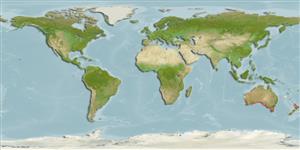Environment: milieu / climate zone / depth range / distribution range
Ekologi
marina; brackvatten revassocierade; djupintervall 1 - 20 m (Ref. 9002). Subtropical
Indo-West Pacific: southern Australia.
Size / Vikt / Age
Maturity: Lm ? range ? - ? cm
Found in rocky reefs in coastal bays and estuaries, often in silty habitat (Ref. 9002). Secretive (Ref. 9002).
Life cycle and mating behavior
Maturities | Reproduktion | Spawnings | Egg(s) | Fecundities | Larver
Kuiter, R.H., 1993. Coastal fishes of south-eastern Australia. University of Hawaii Press. Honolulu, Hawaii. 437 p. (Ref. 9002)
IUCN Red List Status (Ref. 130435)
Threat to humans
Harmless
Human uses
Verktyg
Special reports
Download XML
Internet-källor
Estimates based on models
Preferred temperature (Ref.
123201): 13.8 - 20.6, mean 17.1 °C (based on 288 cells).
Phylogenetic diversity index (Ref.
82804): PD
50 = 0.8750 [Uniqueness, from 0.5 = low to 2.0 = high].
Bayesian length-weight: a=0.00389 (0.00180 - 0.00842), b=3.12 (2.94 - 3.30), in cm total length, based on all LWR estimates for this body shape (Ref.
93245).
Trofisk nivå (Ref.
69278): 3.1 ±0.4 se; based on size and trophs of closest relatives
Fishing Vulnerability (Ref.
59153): Low vulnerability (10 of 100).
Nutrients (Ref.
124155): Calcium = 246 [68, 751] mg/100g; Iron = 0.944 [0.402, 2.437] mg/100g; Protein = 18.5 [17.0, 20.1] %; Omega3 = 0.222 [0.078, 0.605] g/100g; Selenium = 5.15 [1.27, 18.22] μg/100g; VitaminA = 489 [84, 2,686] μg/100g; Zinc = 3.23 [1.51, 6.20] mg/100g (wet weight);
